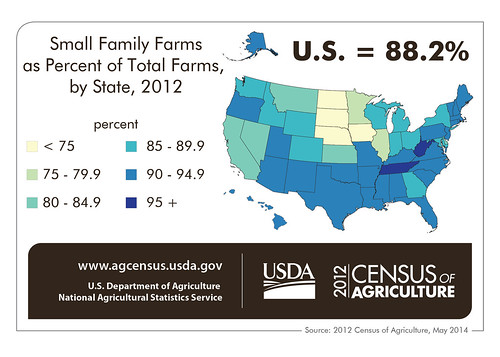
This post is part of the Science Tuesday feature series on the USDA blog. Check back each week as we showcase stories and news from USDA’s rich science and research portfolio.
As you can imagine, Census of Agriculture is a virtual data gold mine for an agricultural demographer. And as we celebrate U.S. agriculture this week, with the help of the Census data we can focus on the key element of our nation’s agriculture – family farms.
Of the 2.1 million farms in the United States in 2012, 97 percent were family-owned operations. Eighty-eight percent of all farms were small family farms. This group included farms such as retirement farms, farms with operators working part-time off-farm, as well as farms with less than $350,000 in gross cash farm income.
Now I know that even $350,000 seems like a lot of money, especially for a small operation, but let’s not forget that this is based only on income. There are also many input costs that go into farming. In fact, out of all of these small farms, only 41 percent reported positive income from farming.
While small family farms represent an overwhelming portion of all farms in the country, not surprisingly they cover a significantly smaller portion of U.S. farmland. In 2012, small farms operated just under half (48 percent) of all farmland and owned 47 percent of the value of farm real estate, which includes land and buildings. They accounted for 20 percent of agriculture sales and 5 percent of the country’s net farm income in 2012. They held 40 percent of the U.S. cattle inventory and 89 percent of the horse inventory, and grew 64 percent of all acres in forage production.
On the demographics front, the youngest farmers among all groups were operators whose primary occupation is off the farm, with an average age of 52.8 years. Retirement farms and low-sales farms had higher proportions of female principal operators (17 and 18 percent, respectively) than did all U.S. farms (14 percent).
This small sampling of the millions of data points starts to show how diverse and important family farms are to the economy and rural America. Yet it barely scratches the surface of available information. There are always new findings and new trends hidden behind all of the numbers. So feel free to peruse the Census data on your own.
And if you’re interested in demographics and women farmer data, policy, and issues, Join Deputy Secretary Krysta Harden on Wednesday March 18 at 2 p.m. for a Google Hangout with Dr. Linda Young, Chief Mathematical Statistician and Director of Research and Development of USDA’s National Agricultural Statistics Service, and Marji Guyler-Alaniz, photographer and founder of FARMHER as we celebrate women farmers and ranchers on National Ag Day. You can tune in at www.usda.gov/live.
